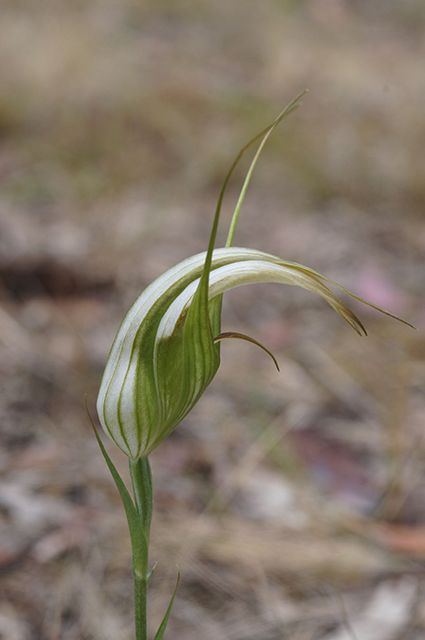There are 19 species of Greenhoods Pterostylis sp. that grow in the Anglesea district.
The flowers ranging in size from the Tiny Greenhood, Pterostylis parviflora, with its small flowers just 9mm long, to our largest species, the Autumn Greenhood, Pterostylis sp. aff. revoluta, whose flowers measure 35 to 40mm.
Winter is the best time to see our Greenhoods, with many species flowering in large numbers at that time, but just now we are being greeted by three of our early flowering species:
Autumn Greenhood, Pterostylis sp. aff. revoluta.

Autumn Greenhood
This species is a spectacular orchid. It grows to about 25cm tall and bears a large solitary, white and green striped flower, brown-tinged at the apex. The flowering stems do not have rosettes.
The long pointed labellum extends prominently through the frontal opening. Unfortunately the orchid is very rare in our district. Some years we have seen large numbers of flowers on private land at Aireys Inlet, but this year my observations have only been focused on a group of five flowers in the Greenhood Reserve again at Aireys Inlet.
Tiny Greenhood, Pterostylis parviflora.

Tiny Greenhood
This species is just starting to appear in the heathlands and open forests. It is not common but is quite widespread.
The tiny green and white flowers face inwards to the stem that often bears just a few flowers. However at times it is exciting to see a flower stalk bearing up to six flowers.
Rosettes of leaves appear at the side of the flowering stalk. They do not encircle it. These orchids should be flowering for the next few months.
Brown-tipped Greenhood, Pterostylis clivosa.

Brown-tipped Greenhood
This newly named orchid is flowering well in many areas although the flowering stems this year are shorter than usual and the flowers appear smaller.
Similar in appearance to the Tiny Greenhood with its small flowers facing inward to the stem, it can be easily distinguished by the brownish tips on the petals and sepals.
Again the rosettes form from the roots beside the flowering plant.
There are signs of other Greenhoods – rosettes of Nodding Greenhoods P. nutans, are starting to appear, Tall Greenhoods, P. melagramma, are in bud and I have seen one Banded Greenhood, P. sanguinea, almost ready to flower.
Of course we mustn’t forget the other autumn orchid species that, despite the dry conditions, are flowering in the district: Fringed Hares, Leporella fimbriata, Autumn Bird Orchids, Chiloglottis reflexa, and Parson’s Bands, Eriochilus cucullatus.
It is a delight to be out in the field at the moment and I hope you can find time to renew your acquaintance with our autumn flowering species.
Photos and descriptions of all these orchids are documented in Orchids of the Anglesea District available from Angair.
Margaret MacDonald